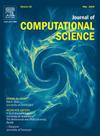A three-stage framework combining neural networks and Monte Carlo tree search for approximating analytical solutions to the Thomas–Fermi equation
IF 3.7
3区 计算机科学
Q2 COMPUTER SCIENCE, INTERDISCIPLINARY APPLICATIONS
引用次数: 0
Abstract
This study presents an innovative framework that integrates physics-informed neural networks with Monte Carlo tree search to develop an approximate analytical solution for the Thomas–Fermi equation. The framework operates in three stages. Initially, a physics-informed neural network is used to generate a numerical approximation of the Thomas–Fermi equation. Subsequently, the Monte Carlo tree search algorithm identifies an analytical expression that closely approximates the numerical solution from the first stage, resulting in an initial analytical solution. In the final stage, the physics-informed neural network is employed once more to optimize the coefficients of the expression found by Monte Carlo tree search, further refining the accuracy of the solution. Experimental results validate the effectiveness of this approach, demonstrating its capability to solve the challenging and nonlinear Thomas–Fermi equation, for which an exact analytical solution is not available.
一种结合神经网络和蒙特卡罗树搜索的三阶段框架,用于逼近托马斯-费米方程的解析解
本研究提出了一个创新的框架,将物理信息神经网络与蒙特卡洛树搜索相结合,以开发托马斯-费米方程的近似解析解。该框架分为三个阶段。最初,一个物理信息的神经网络被用来生成托马斯-费米方程的数值近似。随后,蒙特卡罗树搜索算法识别出与第一阶段数值解非常接近的解析表达式,从而得到初始解析解。在最后阶段,再次使用物理信息神经网络来优化蒙特卡罗树搜索找到的表达式的系数,进一步提高解的准确性。实验结果验证了该方法的有效性,证明了它能够解决具有挑战性和非线性的托马斯-费米方程,对于一个精确的解析解是不可用的。
本文章由计算机程序翻译,如有差异,请以英文原文为准。
求助全文
约1分钟内获得全文
求助全文
来源期刊

Journal of Computational Science
COMPUTER SCIENCE, INTERDISCIPLINARY APPLICATIONS-COMPUTER SCIENCE, THEORY & METHODS
CiteScore
5.50
自引率
3.00%
发文量
227
审稿时长
41 days
期刊介绍:
Computational Science is a rapidly growing multi- and interdisciplinary field that uses advanced computing and data analysis to understand and solve complex problems. It has reached a level of predictive capability that now firmly complements the traditional pillars of experimentation and theory.
The recent advances in experimental techniques such as detectors, on-line sensor networks and high-resolution imaging techniques, have opened up new windows into physical and biological processes at many levels of detail. The resulting data explosion allows for detailed data driven modeling and simulation.
This new discipline in science combines computational thinking, modern computational methods, devices and collateral technologies to address problems far beyond the scope of traditional numerical methods.
Computational science typically unifies three distinct elements:
• Modeling, Algorithms and Simulations (e.g. numerical and non-numerical, discrete and continuous);
• Software developed to solve science (e.g., biological, physical, and social), engineering, medicine, and humanities problems;
• Computer and information science that develops and optimizes the advanced system hardware, software, networking, and data management components (e.g. problem solving environments).
 求助内容:
求助内容: 应助结果提醒方式:
应助结果提醒方式:


